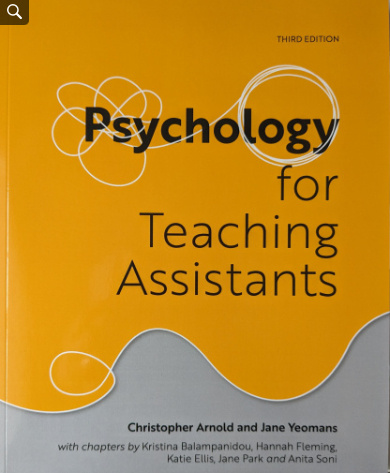
‘Psychology for Teaching Assistants’ by Dr Christopher Arnold and Dr Jane Yeomans is an excellent resource for those who want to support children with SEND. It outlines the psychology of human development, the psychology of learning and the psychology of institutions and groups.
Both authors worked as teachers before becoming Senior Practitioner Educational Psychologists. This book is a core training text for TAs, including those studying for foundation degrees, teaching certificates and NVQ level 3/4 qualifications.
According to the DfE, in 2011, there were 218,690 teaching assistants in schools. By 2021, there were 263,913. They represent 27.9% of all staff in schools in England, yet their role and training needs are often sidelined.
This latest edition covers:
- Attachment theory
- Language development
- Working with disaffected teenagers
- The emotional impact of loss, including discovering disability in a child
- The psychological effects of abuse
- Cognitive curricula, empowering learning through independence
- Processes in groups
- Working in breakfast and after-school clubs
- Working in learning support units
- Leadership models
- Interpersonal communication
- Violence, aggression and bullying
- Emancipatory psychology
- The Emotional Literacy Assistant Programme (ELSA)
- Neurodiverse young people
- Children’s internal worlds
Supporting TAs in the classroom
This book will give TAs a thorough grounding in child development, classroom management and learning styles. Its research-guided techniques enable TAs to:
- Understand the challenges children face
- Implement effective teaching methods
- Recognise children’s social and emotional needs
- Identify strategies to support a range of learning styles
- Create a positive and inclusive classroom environment
In addition, the book explores the various schools of psychology used in today’s classrooms, evaluating the results and appropriateness of each:
Behavioural Psychology, with its reward systems and sanctions, is often seen as a way of encouraging discipline. It is less successful as a motivator as merit badges and detentions have little impact on secondary pupils.
Experiential Psychology shows that our sense of self is central to wellbeing, but as schools are driven by timetables and programmes of work, children can find they have little choice about what they do in lessons and their individuality is lost in the mass.
Social Constructivism is where our learning is not an individual endeavour but something we construct through our dealings with others. This can be a positive as we expand our knowledge of other ways of looking at the world, but it also has its downsides, as shown by the negative voice in some children’s heads (‘I’m no good at this’) and the learned helplessness that can ensue.
Cognitive Psychology is about mental processes including memory, perception, attention, motivation and conceptualisation, leading to intellectual development. It focuses on the process of learning. However, while we know that children need to learn how to learn and that it is a vital component for success in their life post-school, the current education system’s obsession with a knowledge-based curriculum may not emphasise these skills enough.
Psychodynamic Psychology is based on the work of Freud. It shows how we can build trust and help children form healthy relationships with others. It can be a useful basis for nurturing groups and developing therapeutic approaches for children with social and emotional difficulties.
Emancipatory Psychology looks at the issue of power and considers hierarchies and agency. It is interesting to consider this in connection with how it may affect children’s behaviour, especially in their teenage years, but also to reflect on the way TAs are treated. Power play can be detected in the vocabulary and language register used by staff. Status is not just about pay grade: it is about consultation and involvement in the decision-making process. An understanding of power dynamics can empower learners and TAs.
Inclusion and a history of SEND

The authors provide a fascinating history of education that shows how we have moved from a model of adults instructing children to a form of inclusive education where adults support children in their development. It started in 1755 when the first school in the world for deaf learners opened in Germany. In 1907, Montessori developed programmes for children deemed ‘ineducable’.
30 years later, Piaget was investigating the origins of childhood intelligence; in 1939, Skinner published ‘The Behaviour of Organisms’ and in 1944, secondary education for all was established with 11 classifications of children, although there was still a category called ‘ineducable’. The Warner Report looked at integration instead of segregation while the 1988 Education Reform Act introduced the National Curriculum and SATs, which made inclusion more difficult. Here the work of TAs became more prominent as they helped children to access mainstream settings.
Models of learning
While the first half of the book gives the reader a thorough grounding in psychology and child development, Part Three begins with a focus on an individual child – nine-year-old Jennifer, who has always lagged behind other children in language development, reading and writing. She doesn’t understand place value and has a reading age below six. The authors look at Jennifer through a biological lens, examining memory and concept-building and introducing Gardner’s theory of multiple intelligences.
However, as we have discovered, learning does not take place in a vacuum; we are affected by the people around us. With the right support and approval, Jennifer is confident and makes progress step by step – but at the first sign of disapproval she retreats into herself; this is an example of behavioural psychology in action. Post-Skinner, this approach to the use of rewards, repetition and reinforcement has become the basis of much drill and practice software.
The authors discuss approaches that might help Jennifer. These include accelerated learning, developing a hierarchy of learning and precision teaching with references to Vygotsky’s theory of scaffolding (where learners are given intense support which is gradually withdrawn as they become more confident and competent).
The authors also discuss Feuerstein’s work with Holocaust survivors. While some judged them to have low intelligence, Feuerstein demonstrated that they had simply been impacted by trauma. His view was that learning cannot be separated from experience and culture, but given the right opportunities individuals can change and develop the ability to think. His approach is seen in programmes such as Instrumental Enrichment.
An invaluable study aid for TAs
Each of the book’s chapters begins with three or four bullet points summarising the content. It covers the history of education in the UK, introducing readers to some of the important figures who have shaped educational thinking over the years. It also contains case studies with examples that will resonate with those working in schools, as well as ‘thinking points’ and activities so that readers can apply their new knowledge more practically, all accompanied by an excellent index which makes it easy to track references. All of the book’s contributors are practising educational psychologists, and their work is a valuable resource for teachers and school managers as well as TAs.
Register for free
No Credit Card required
- Register for free
- Free TeachingTimes Report every month